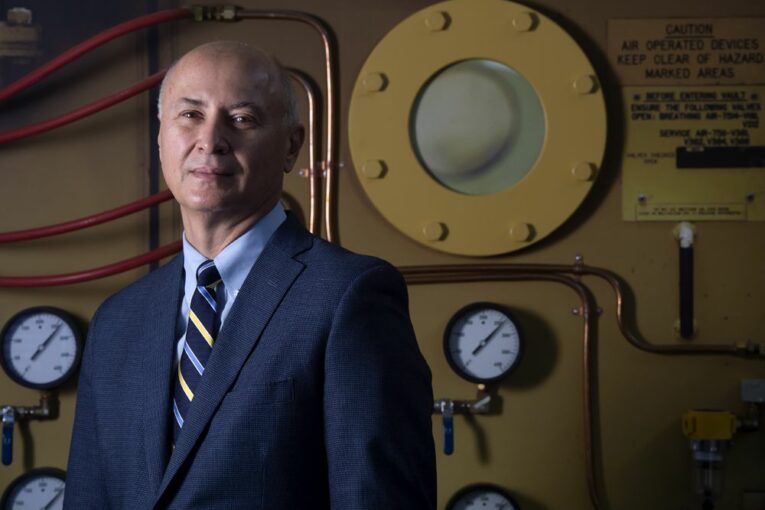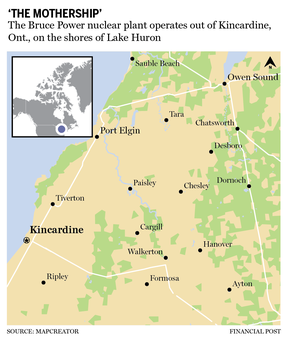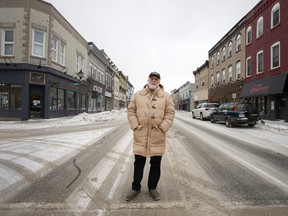
The American industrial heartland was reeling in the early 1980s, battered by a recession and the great rusting out of the country’s steel industry, among others. Once mighty one-industry towns, such as Weirton, WV, bled away good-paying, blue-collar jobs.
Walter Rencheck, a 58-year-old steelworker, was one of the casualties. To help bridge the gap between being forced into early retirement at the steel mill and collecting Social Security, he asked his son, Mike — a bright, young electrical engineer dreaming of broader horizons — to put those dreams on hold to support the family and take a job at the nearby nuclear plant in Slovan, Penn.
Rencheck had interviews lined up with Texas Instruments Inc., Westinghouse Electric Corp. and some of the big defence industry firms, but he knew full well where he was headed: home.
But what was meant to be a stopgap gig at the Beaver Valley Power Station would turn into a 12-year run: a hands-on education in all things nuclear, from plant maintenance to outage management, and from reactor startups to engineering whatsits.
The experience helped chart a course to the chair Rencheck now occupies as the chief executive at the centre of a massive, multi-year, $13-billion-plus overhaul of a Canadian nuclear powerhouse.

The influx of investment at Bruce Power LP, located near Lake Huron beach country three hours northwest of Toronto, has ignited the economic fortunes of the surrounding area, bringing jobs, businesses, people, optimism, development proposals, runaway real estate prices and all the other good (and bad) things that herald a boom. It is growth gone, well, nuclear, and the steelworker’s son has a plan to make it self-sustaining.
“We started off by thinking: how can we stimulate the economy?” he said.
What Rencheck initially noticed while driving through a region that roughly runs from the small town of Kincardine in the south to Owen Sound in the east and Port Elgin to the north, with the Great Lake as its western boundary, was that it hadn’t recovered from the 2008-09 recession.

In Rencheck’s mind, the scene didn’t add up: Bruce Power generates a third of the electricity required to power the country’s most populous province. Untold millions of dollars had historically been invested in the plant, but beyond the gate was an industrial barren land. Manufacturing-grade buildings largely sat empty.
“Where were all the businesses?” he wondered. “Where were all the companies?”
Rencheck, who was hired in 2016, set out to change the financial landscape through corporate diplomacy, understated arm-twisting, community cheerleading, dialogue with local politicians and planners, and a clear message that the way things had been done at Bruce Power weren’t the way things would be done going forward.
He took his message on the road, and among his first stops was a boardroom at Cambridge, Ont.-based BWXT Canada Ltd. Few players on the Canadian nuclear scene have been around as long as BWXT, whose American parent company was founded in 1856. (Inventor Thomas Edison described the “B&W” boiler as “the best boiler God has permitted man yet to make.”)
Today, the company’s steam generators are found in 300-plus Candu reactors globally. On the domestic front, it’s the one to call if you’re in the market for a steam generator.

But Rencheck came in with an even bigger pitch: Billions were to be spent on a plant overhaul that won’t be completed until the 2030s, ensuring the plant itself would thereafter keep splitting atoms until 2064. For it to be sustainable over the long haul, he reasoned, the entire region needed to thrive alongside it.
That meant the BWXTs of the world — and the company was ultimately awarded a $642-million contract to supply 32 steam generators to Bruce Power — would need to set up operations locally.
“You have a social purpose here, you need to help some of these communities,” Rencheck said.
To further emphasize this point, tendered bids for work on Bruce Power would henceforth not be graded solely by a bidder’s ability to deliver quality at a good price, but by the company also having a strong local presence.
“What is novel here is that Mike has created an environment where you are clearly rewarded if you are invested in that local economy, and so it changed the business paradigm,” John MacQuarrie, president of BWXT’s nuclear group said. “He has driven a lot of us to think differently about being local.”
You have a social purpose here, you need to help some of these communities
Mike Rencheck
It wasn’t just talk, either. BWXT established a satellite manufacturing facility in what was once an old auto-glass factory in Owen Sound, investing about $1 million to repurpose it, and running two shifts to meet demand.
The plant slides between 25 and 50 full-time employees, depending on delivery timelines, and it has already attracted new customers, aside from Bruce Power. Its employees, meanwhile, live, shop and pay taxes in the region, and MacQuarrie said the company is hiring.
Toronto-based electricity service provider Kinectrics Inc., another major supplier, has invested close to $100 million in the area, including a new 40,000-square-foot laundry facility in tiny Teeswater. Five years ago, there were 10 Bruce Power suppliers operating in the region. Today, there are more than 60.
Going local is not completely driven by altruism. There is a sound business rationale behind the push. Rencheck understands that a work force rooted in the area, that plays together and has kids that go to the local schools together is more inclined to stay together. Camaraderie can be key when toughing out a project that, by law of averages, isn’t guaranteed to go entirely smoothly over the next 10 to 15 years.
Which is to say: all booms have bumps. Gerry Glover, the rookie mayor of Kincardine, a town with a pretty main street and a beach to linger by, is among those trying to manage the bumps.
Glover, speaking so quickly that he apologizes to his listener as he blazes ahead, describes Bruce Power as a great partner. When Glover has concerns, he makes a call and Rencheck will call him back.
Locals jokingly refer to the plant, and its 4,000-plus employees with their good salaries and benefits, as “The Mothership.” Its operations boost Ontario’s gross domestic product (GDP) by $4.03 billion and support an additional 13,400 full-time jobs, according to a Jupia Consultants Inc. report using data from 2020.
Thanks to Bruce Power and its employees, as well as the big city COVID-19 refugees who cashed out their houses for homes in beach country during the pandemic, Kincardine’s main street has been opening businesses, not closing them, since March 2020.

The town’s median household income is 16 per cent higher than the Ontario average, according to the mayor. Public schools are bursting at the seams, and a new school is being built. The local hospital is undergoing an expansion. The town is brimming with life, so much so that it’s having some trouble dealing with the pace of change.
“With so many people moving in, one of the challenges we have as a small tax base is the challenge of keeping up with the growth in terms of infrastructure,” Glover said.
Another problem: not everybody in town has a good-paying job working for Bruce Power.
A lot of people are living paycheque to paycheque and don’t make $50 an hour
Gerry Glover
“A lot of people are living paycheque to paycheque and don’t make $50 an hour,” Glover said.
Even the mayor would have trouble buying a home in town now.
Glover and his wife sold their place in Kincardine a few years back, and moved to the village of Tiverton, where he can see “fireflies” at night. Before the house was even listed, a buyer appeared out of the blue, offering to pay the couple $100,000 more than asking. A house there that sold for less than $300,000 in 2016, sells for almost $600,000 today.
“Real estate in the area has gone nuts,” said Rick Clarke, a retired high school principal who moved to Kincardine with his wife, also a retired principal, about 15 years ago.

He helps out with the local business improvement association, and he likens Kincardine to a “company town” of yesteryear.
On one hand, there’s the engineer working for the company with a six-figure salary. On the other hand, there is the single mom working the cash register at the grocery store, ringing through the engineer’s order, as well as doing two other jobs just to cover her rent. That’s assuming she can actually find a place that hasn’t already been rented at a premium to a contractor doing work at Bruce Power.
“There is a good side to this and a bad side,” Clarke said. “It all depends on who is paying your cheque.”
It all depends on who is paying your cheque
Rick Clarke
What outsiders often overlook amid the hurly-burly around Bruce Power is that there was life in the area long before the first two reactors came into service in 1977.
“I honestly had no idea what went on at Bruce Power until 18 months ago,” local restaurateur Jennifer Christie said.
She admires the power company’s push to get its suppliers to establish local roots and contribute to the fabric of the region. But she bristles at the perception of the area, pre-life-extension program, as a veritable economic dead zone, populated by hillbillies and retirees scrimping their every penny.
Christie’s extended family has farmed in the region for six generations. Her parents’ 1,500-acre mixed grain-and-dairy operation is just southwest of the village of Tara.
Jim and Helen Christie are no hillbillies. Like many farmers, they surf on the cutting edge of an industry that has gone high tech, strives for sustainability and thrives on innovation, including using robots to milk their herd of 75 cows.
“I grew up on the farm,” Christie said, noting she grew up with fall fairs, snowmobile clubs, community fundraisers, legion hall dances and a high school teacher who encouraged her to go to university, work and, when the time came, bring the best of her experiences home to further enrich the place.
And that’s exactly what she has done, lately pivoting from a life as a lead marketer in Ottawa to buying a pretty red brick building on the main street in Paisley, population 1,000. She and her partner, chef Chris Shaw, opened Bonfire on Queen in April 2020. They sling beef-and-prosciutto lasagna and other Italian delicacies featuring ingredients sourced from local farmers.
“It is not only about Bruce Power around here,” she said.

Indeed, it is not, although Bruce Power employees are still among her best customers.
Christie is also involved in a regional business accelerator program geared to entrepreneurs. Peering into the future, she envisions a great mix of talents — be they nuclear engineers, local artists, heavy mechanics, organic farmers, small-business owners or all of the above — exchanging ideas, trying new things and building something metaphorically bigger than the power plant that powers the region.
Her vision has a contagious quality to it: she truly believes that what is happening today is a beginning, the start of a great uncorking of potential that could sustain the regional economy long after the nuclear plant goes dark.
Christie is not the only believer. Rencheck has been talking to suppliers, local politicians and planners about his belief for years.
It is a paradise here. The water is crystal clear
Mike Rencheck
The reactor life extension program won’t last forever, so there needs to be the conviction that the region can build for the immediate boom — more housing, a new school, a hospital expansion, new bridges, roads, sewers, and more and more — and imagine what life could look like beyond it.
“As I look at it, we are starting to spin up, and I think the ‘I Believe’ button has been pressed,” Rencheck said.
The chief executive has certainly pressed it in his personal life. In theory, the American-born boss could have done his job in a sleepy corner of Ontario on a fly-in basis. He was deputy chief operating officer of French nuclear power, Areva SA, before retiring to Columbus, Ohio, eight months before coming out of retirement to take the Bruce Power job.
But instead of commuting, Rencheck and his wife, Carol, built a house with a view of Lake Huron. Last September, they became Canadian citizens.
“I’ve got a passport to prove it, even,” he said. “It is a paradise here. The water is crystal clear.”
There is also Tim Hortons — Rencheck developed a weakness for the franchise’s doughnuts in Columbus — and plenty of people to talk hockey with (he is a Pittsburgh Penguins fan, so, of course, Sidney Crosby is his favourite player).
In true, stereotypical Canadian fashion, Rencheck heaps praise upon his colleagues, insisting that what is happening in the area isn’t about him at all. His colleagues are incredibly “nice,” by the way.
“I couldn’t ask for a better place to be,” he said.
The West Virginia steelworker’s son has made a new home on a Canadian lake, with a vision of the future that has only just begun.
• Email: [email protected] | Twitter: oconnorwrites
You can read more of the news on source
